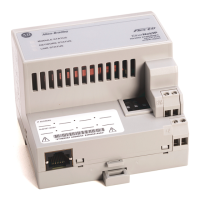Rockwell Automation Publication 1794-UM066C-EN-E - April 2023 7
Chapter 1
Overview of FLEX I/O and Your Redundant
EtherNet/IP Adapter
Overview This chapter provides a description of the FLEX I/O dual-port EtherNet/IP adapters and an overview
of how they communicate with programmable controllers.
The FLEX I/O System The FLEX I/O system is a small, modular I/O system for distributed applications that performs all of
the functions of rack-based I/O. Figure 1 shows the components of a FLEX I/O system.
Figure 1 - FLEX I/O System Components
• Adapter – Transfers read and write configuration data to and from the I/O module
• Terminal base – Contains a terminal strip to terminate wiring for two- or three-wire devices
• I/O module – Contains the bus interface and circuitry that is needed to perform specific
functions that are related to your application
The FLEX system consists of an adapter, terminal base unit, DIN rail, power supply, and adapter
cabling components. You can use up to eight terminal bases per adapter.
For detailed instructions on how to set up and install your module, see Install Your FLEX I/O Adapter
on page 11.
Adapter Features The 1794-AENTR and 1794-AENTRXT adapter features include:
• Use of EtherNet/IP messages encapsulated within standard TCP/UDP/IP protocol
• Common application layer with ControlNet® and DeviceNet®
• Interfacing via Category 5 rated twisted-pair cable
• Half/full duplex 10 Mbit or 100 Mbit operation
•DIN rail mounting
• Communication to and from other FLEX I/O modules on the same DIN rail
• Communication supported by RSLinx® software
• IP address assigned via standard BOOTP/DHCP tools
• I/O configuration via Studio 5000 Logix Designer application
• No network scheduling required
• No routing tables required
Adapter I/O moduleTerminal base

